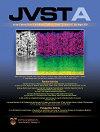单质Ir和Ru薄膜的固体源金属有机MBE
IF 2.1
3区 材料科学
Q3 MATERIALS SCIENCE, COATINGS & FILMS
引用次数: 0
摘要
元素金属薄膜在现代电子纳米器件中发挥着非常重要的作用,如传导通道、间隔层、自旋电流发生器/探测器以及许多其他重要功能。在这项工作中,我们利用固体金属-有机源前驱体的化学性质,展示了分子束外延合成元素Ir和Ru金属薄膜的方法。当金属有机前驱体在衬底表面分解时,金属相的热力学和动力学选择使这些金属的合成成为可能。结合原位和非原位结构和成分表征技术,研究了不同条件下薄膜的生长。在前驱体吸附、分解和晶体生长的背景下,讨论了衬底温度、氧反应性和前驱体通量对调节薄膜组成和质量的关键作用。计算热力学将金属或氧化物形成的驱动力量化为合成条件和化学势变化的函数。这些结果表明,体热力学是在低温下形成Ir金属的一个合理的起源,而Ru金属的形成可能是由动力学介导的。本文章由计算机程序翻译,如有差异,请以英文原文为准。
Solid-source metal-organic MBE for elemental Ir and Ru films
Thin films of elemental metals play a very important role in modern electronic nano-devices as conduction pathways, spacer layers, spin-current generators/detectors, and many other important functionalities. In this work, by exploiting the chemistry of solid metal-organic source precursors, we demonstrate the molecular beam epitaxy synthesis of elemental Ir and Ru metal thin films. The synthesis of these metals is enabled by thermodynamic and kinetic selection of the metal phase as the metal-organic precursor decomposes on the substrate surface. Film growth under different conditions was studied using a combination of in situ and ex situ structural and compositional characterization techniques. The critical role of substrate temperature, oxygen reactivity, and precursor flux in tuning film composition and quality is discussed in the context of precursor adsorption, decomposition, and crystal growth. Computed thermodynamics quantifies the driving force for metal or oxide formation as a function of synthesis conditions and changes in chemical potential. These results indicate that bulk thermodynamics are a plausible origin for the formation of Ir metal at low temperatures, while Ru metal formation is likely mediated by kinetics.
求助全文
通过发布文献求助,成功后即可免费获取论文全文。
去求助
来源期刊

Journal of Vacuum Science & Technology A
工程技术-材料科学:膜
CiteScore
5.10
自引率
10.30%
发文量
247
审稿时长
2.1 months
期刊介绍:
Journal of Vacuum Science & Technology A publishes reports of original research, letters, and review articles that focus on fundamental scientific understanding of interfaces, surfaces, plasmas and thin films and on using this understanding to advance the state-of-the-art in various technological applications.
 求助内容:
求助内容: 应助结果提醒方式:
应助结果提醒方式:


